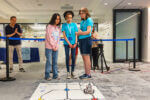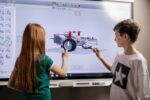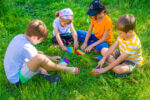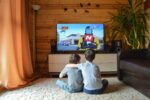A recent webinar featuring a well-known author and educator offers parents and teachers fascinating insight and practical information to help them boost children’s early learning and development.
This free webinar was sponsored by EdWeb.net and is still available for viewing or PDF download. Dr. Pam Schiller focuses on ages 3 – 5 and draws on extensive research about child brain development.
Here are some highlights of the 10 ways you can enhance a child’s learning abilities:
1. Singing
Dr. Schiller likes singing for a number of reasons. On a physical level, singing “energizes” the brain, as it promotes deep breathing, increasing oxygen intake which makes children more alert and enhances memory. Singing also helps children make transitions, from one activity to another, or moving from one space to another, readying their brains to learn something new. And the lyrics and rhyming words boost literacy.
2. Ensure Emotional Safety
Just as a child can’t learn when she is hungry, cold, sick, or tired, a child who doesn’t feel safe and secure cannot learn. An atmosphere of threats and punishments will shut down learning; conversely, an environment of trust in which a child feels cared for and nurtured readies his brain to absorb new information.
3. Employ Calming Strategies
Dr. Schiller says that for very young children, the majority of each day’s experience can feel new and potentially jarring. So, calming strategies are a key to learning potential. She recommends simple exercise, pretending to be a water faucet that opens up and drains out to relieve stress, and this deep breathing exercise, repeated several times: pretend to smell a flower…now pretend to blow out a candle.
4. Keep It Simple
According to Dr. Schiller, our brains receive literally thousands of bits of information every second, both internally and through the senses – and by far the most are from visual stimuli. Teachers and parents of young ones tend to make this information overload worse. Busy, cluttered rooms and classrooms can feel overwhelming. Better to cut down on visual clutter and limit a child’s choice of activities to two or three options, in order to make a more thoughtful, less stressed decision. Less is more for early learners.
5. Pay Attention to Attention Span
According to research, a child’s initial attention span is about one minute per year of age. So a 3-year-old starts with a three-minute attention span. The average for adults is 20 minutes, before our minds begin to wander. Dr. Schiller says we can boost this ability, with practice, to three times that amount. In other words, 3×3 is a nine-minute span for a 3-year-old; 4×3 means 12 minutes for a 4-year old. Similarly, for adults, 3×20 minutes, or an hour, is generally the limit. This has obvious implications for learning. Once attention span is exhausted, the brain can hold merely 20% of what’s being conveyed. In other words, for young children, break learning down into short pieces.
6. Focus and Reflect
For little kids, it’s critical to first focus their attention, convey the learning, and then reflect on what’s been learned. Dr. Schiller suggests, for example, that focus can be launched by having a finger puppet ask a question. Focusing a learner helps ensure they are “fully present” in the moment. Just as important is to invite children to think about what they’ve just learned. As she says, the brain needs time to process anything new. Letting a child reflect by speaking is critical, since the spoken word helps them cement what’s been learned.
7. Laughing
A joyful brain processes learning much better, and humor reduces stress, enhances emotional safety, and increases the brain’s production of endorphins (chemicals that produce a euphoric feeling). Dr. Schiller asks us not to forget laughter as part of learning. Funny books, like those of Dr. Seuss, are great. So is the use of a Muppet puppet to make kids laugh.
8. Use Colors and Aromas
Children through age five are five times more sensitive to color and aroma than adults. And the optimum color for learning is yellow. Yellow puts children in a more alert state and helps children focus. Bright red and orange have a similar effect, while cool colors such as blue, green, and purple calm us down. Scents such as peppermint and cinnamon also boost alertness, while lavender and rose are calming. Wearing a dash of bright color, using yellow construction paper, putting mint into play dough, using potpourri…all can be effective strategies. Though, she says, keep it varied so colors and aromas aren’t simply repeated, as kids will start to ignore them.
9. Provide Repetition/Practice
Dr. Schiller compares repetition to driving down a road. A first encounter with new information is like driving on a bumpy dirt road. Subsequent encounters begin to smooth that road out until it’s nicely paved. And when the practice really sinks in, it’s like driving on a superhighway. Her point is that repetition “strengthens neural connections” in the brain. And when a new skill or information isn’t practiced, the brain won’t think it’s needed and will “wash it away.” Asking a child, “What did we learn yesterday?” is one simple way to repeat and learn.
10. Windows of Opportunity
This is Dr. Schiller’s most complex point, represented by this chart:
Based on research, early child development needs to be “wired” in a fundamental way during critical “windows” of time. Once established in a positive way, these skills can be continually enhanced as a child grows. However, if the window is missed, the enhancement may never catch up. For example, if a baby is in an uncaring, untrustworthy environment, that child may never fully believe he can trust anyone. Similarly, a child who isn’t spoken or read to through age 2 will be well behind other children who had that “wiring” opportunity. (For a more detailed explanation of this important point, please view the webinar or download the PDF.)
Finally, many parents of preschoolers have found online early learning programs are an effective tool for enhancing children’s early learning and development.
What do you think of these ideas? Feel free to leave a comment and add your thoughts!
Image Credit – Lars Plougmann / CC by 2.0






























































































